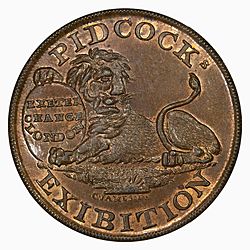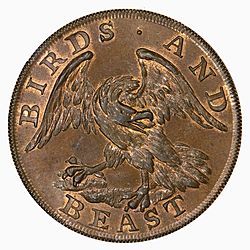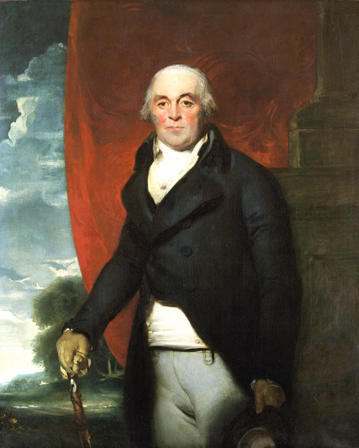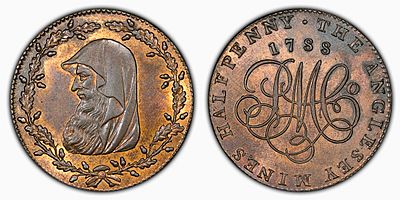Conder token facts for kids
Conder tokens, also called 18th-century provincial tokens, were special coins made by private businesses. They were used in the late 1700s and early 1800s in England, Anglesey, Wales, Scotland, and Ireland.
These tokens became popular because there weren't enough small coins for everyday shopping and paying workers. The Industrial Revolution meant more factories and more people needing wages. Also, many fake coins were circulating. Since the government didn't make enough new coins, business owners started making their own.
The first of these tokens appeared in 1787. They were used to pay workers at a mine company. By 1795, millions of these tokens, with thousands of different designs, were used all over Great Britain. People have collected Conder tokens since they were first made. This is why many well-preserved examples exist today.
Contents
History of Conder Tokens
Why There Weren't Enough Coins
For a long time, Great Britain didn't have enough small coins. This made it hard for people to buy things and for workers to get paid. The problem got much worse in the mid-1700s. During the Industrial Revolution, many people moved from farms to work in factories. Factories needed to pay many workers, but there weren't enough coins.
The population of Great Britain also grew very fast between 1750 and 1800. To make things worse, many fake copper coins were in use. The official Royal Mint rarely made new copper or silver coins. In fact, King George III stopped making copper coins at the Royal Mint in 1775.
In 1768, a huge amount of copper was found at Parys Mountain in Wales. In 1785, Thomas Williams, who owned the Parys Mine Company, offered to supply copper to the Royal Mint for new coins. He even offered a special way to make the edges of coins to stop fakes. But the Royal Mint said no.
By 1786, about two-thirds of the coins in Britain were fake. The Royal Mint then closed down, making the coin shortage even worse. The Royal Mint didn't make any copper coins for 48 years, from 1773 to 1821.
So, in February 1787, Thomas Williams started making his own copper tokens. Some were used to pay his workers at the Parys Mine Company. These first tokens showed a hooded Druid. Soon, other cities and businesses started making their own small coins too.
Matthew Boulton and The Soho Mint
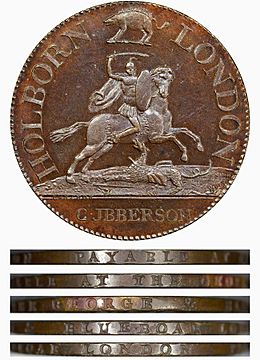
As the need for small coins grew, copper tokens became very popular. One of the biggest makers of these private tokens was Matthew Boulton. He made millions of them for different merchants. Boulton was already good at making small metal items, like buckles, from his family business.
In the mid-1780s, Boulton became interested in making coins. He saw them as just another small metal product. He also owned parts of several copper mines and had a lot of copper. Boulton refused to make fake money. In 1788, he opened the Soho Mint as part of his factory. This mint had eight steam-powered machines that could make 70 to 84 coins every minute!
Boulton tried hard to get a contract to make official British coins. But in 1790, the government put off making a decision. Meanwhile, the Soho Mint made coins for other places like the East India Company and Russia. They also made blank coins for other countries to use. For example, they sent over 20 million blanks to the United States Mint.
Britain's money problems became very bad in 1797. The Bank of England even stopped exchanging its paper money for gold. To get more money into circulation, the government decided to issue many copper coins. They gave a contract to Matthew Boulton in March 1797.
King George III announced that new copper coins would be made to help "the laborious poor." These new coins, like twopence and pennies, were made at the Soho Mint starting in 1797. Halfpennies and farthings followed in 1799. With many official government coins now available, the need for private tokens slowly disappeared.
Government Coins Return
By 1802, private businesses stopped making their own tokens. However, over the next ten years, the value of copper increased. This meant people started melting down the government's copper coins to sell the metal. So, by 1811 and 1812, private tokens started appearing again.
To stop this, the Royal Mint began a huge program in 1816 to make many new gold and silver coins. In 1817, a new law was passed that made it illegal to make private tokens. There were very strict punishments for breaking this law. Finally, the Truck Act 1831 made it illegal for employers to pay their workers with tokens.
Collecting Conder Tokens
Early Collectors
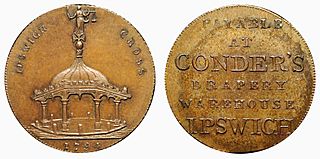
At first, private tokens were just used for daily transactions. But by 1793, collecting and trading these tokens became a very popular hobby. Many tokens made in the early years were meant to be used as money. However, token makers soon realized they could make special designs in very small numbers and sell them directly to collectors for a good profit.
Some clever collectors even paid to have their own unique tokens made in small quantities. They would then trade these "rare" tokens with other collectors to get more varieties for their own collections. This collecting craze was so big that three major books about indexing and collecting provincial tokens were published before 1800. These books were written by collectors, not by expert coin researchers. Because so many people collected them, many Conder tokens today are in excellent condition. They were carefully kept in private collections for decades.
Topics and Designs
Since Conder tokens were not made by the government, their creators had the freedom to put almost anything on them. They could make political statements, share social messages, honor important people or events, or simply advertise their businesses.
You can find tokens showing famous people like Isaac Newton, or topics like the end of slavery (Abolition). Some tokens showed prisons, mental hospitals, or even circus performers. Anyone with the money and desire could make their own coin. Many tokens were officially only usable in certain areas. However, people generally treated these copper tokens like real money, and they were used widely. By 1795, there were thousands of different designs, most of them being halfpennies.
See also
- Local currency
- Private currency


